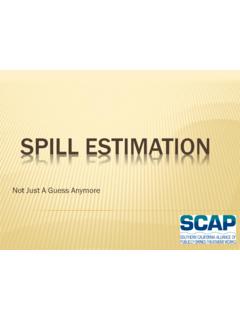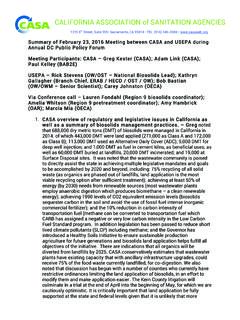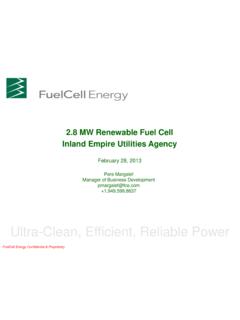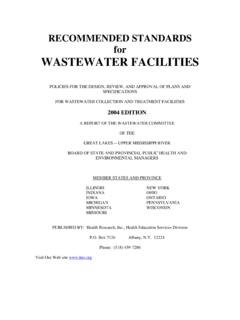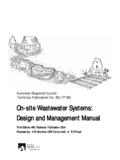Transcription of EMERGENCY RESPONSE P GUIDANCE FOR WASTEWATER …
1 EMERGENCY RESPONSE PLAN. GUIDANCE FOR. WASTEWATER SYSTEMS. 2004. In Collaboration with EPA. The Water Environment Research Foundation, a not-for-profit organization, funds and manages water quality research for its subscribers through a diverse public-private partnership between municipal utilities, corporations, academia, industry, and the federal government. WERF subscribers include municipal and regional water and WASTEWATER utilities, industrial corporations, environmental engineering firms, and others that share a commitment to cost-effective water quality solutions. WERF is dedicated to advancing science and technology addressing water quality issues as they impact water resources, the atmosphere, the lands, and quality of life. For more information, contact: Water Environment Research Foundation 635 Slaters Lane, Suite 300. Alexandria, VA 22314-1177. Tel: (703) 684-2470. Fax: (703) 299-0742. Copyright 2004 by the Water Environment Research Foundation.
2 All rights reserved. Library of Congress Catalog Card Number: 2004115486. Printed in the United States of America This report was prepared by the organization(s) named below as an account of work sponsored by the Water Environment Research Foundation (WERF). Neither WERF, members of WERF, the organization(s) named below, nor any person acting on their behalf: (a) makes any warranty, express or implied, with respect to the use of any information, apparatus, method, or process disclosed in this report or that such use may not infringe on privately owned rights; or (b) assumes any liabilities with respect to the use of, or for damages resulting from the use of, any information, apparatus, method, or process disclosed in this report. PA Consulting Group This document was reviewed by a panel of independent experts selected by WERF. Mention of trade names or commercial products does not constitute WERF nor EPA endorsement or recommendations for use.
3 Similarly, omission of products or trade names indicates nothing concerning WERF's nor EPA's positions regarding product effectiveness or applicability. The research on which this report is based was funded, in part, by the United States Environmental Protection Agency through Cooperative Agreement No. R-83075101 with the Water Environment Research Foundation (WERF). Unless an EPA logo appears on the cover, this report is a publication of WERF, not EPA. ii ACKNOWLEDGMENTS. Project Subcommittee Brian Frazer, WSD, EPA. Clifford J. Arnett, Columbus Water Works Jonathan Herrmann, EPA, NHSRC. Alan Hais, EPA, ORD. B. Narayanan, Carollo Engineers Schardein, Jr., Louisville and Jefferson Metrotropolitan Sewer District Timothy G. Shea, CH2M Hill Stakeholder Group Bruce Aptowicz, City of Philadelphia Water Department,PA. Paul Bennett, New York City Department of Environmental Protection, NY. Gary Binderim, Severn Trent Services, Inc., Houston, TX. Mary Alice Dunn, National Environmental Training Center for Small Communities (NETCSC).
4 R. Michael McDaniel, Metropolitan Sewer District of Greater Cincinnati,OH. Moshen Moayedi, City of Los Angeles,CA. John G. Petito, , New York City Department of Environmental Protection, NY. Rich Sustich, Metropolitan Water Reclamation District of Greater Chicago, IL. Project Team: Kenneth Rubin, Principal Investigator, PA Consulting Group Laura M. Nuzzo, Project Manager, PA Consulting Group Robert Glassen, SCIENTECH. Charlene Greene, , SCIENTECH. Daniel C. Rees, SCIENTECH. Brian S. Maddox, White Shield Safeguards and Security Hasmik Malumian, PA Consulting Group Paul Whitaker, PA Consulting Group EPA Project Officer Curt Baranowski, Project Officer, Water Security Division Water Environment Research Foundation Staff Director of Research: Daniel M. Woltering Project Manager: Roy Ramani EMERGENCY RESPONSE Plan GUIDANCE for WASTEWATER Systems iii ABSTRACT. EMERGENCY RESPONSE planning is an essential part of managing a WASTEWATER system , and a process by which WASTEWATER system managers and staff explore responses to vulnerabilities, make improvements, and establish procedures to follow in an EMERGENCY .
5 It is also a process that encourages people to form partnerships and better understand support capabilities. Preparing an EMERGENCY RESPONSE plan and practicing it can save lives, prevent illness, enhance system security, minimize property damage and environmental impact, and lessen liability. Results from research regarding the current status of EMERGENCY RESPONSE planning within the WASTEWATER community indicates that most systems would welcome GUIDANCE with the EMERGENCY planning process, and are receptive to information regarding what should be included in an EMERGENCY RESPONSE plan. This document is intended to provide WASTEWATER systems with voluntary GUIDANCE on development of EMERGENCY RESPONSE plans for natural or manmade ( , terrorist related) events, and to provide a reference for the types of information and data that should be included in an EMERGENCY RESPONSE plan. This Document : Supports the development of WASTEWATER system EMERGENCY RESPONSE plans by providing suggestions regarding content material, plan structure and organization, and additional informational sources.
6 Illustrates important EMERGENCY planning concepts in a WASTEWATER system context such as chain- of-command, communication and notification plans, personnel safety provisions, plan initiation and decision making process, EMERGENCY operations centers, EMERGENCY RESPONSE training, and plan evaluation. Provides a starting point for the development of Action Plans that can be used by a WASTEWATER system to address specific vulnerabilities or high-risk threat scenarios identified in the system 's vulnerability assessment, and to provide a specific RESPONSE to a given incident. Enables WASTEWATER systems to save time and money by utilizing the GUIDANCE document as a template for their EMERGENCY RESPONSE plan. Provides GUIDANCE regarding man-made or terrorist related threats that historically have not been addressed in WASTEWATER system EMERGENCY RESPONSE planning efforts. Keywords: Incident command, threat, recovery, mutual aid agreement, action plans, notification iv TABLE OF CONTENTS.
7 Purpose ..1-1. Goals ..1-1. Access ERP Organization ..1-2. General EMERGENCY Planning Information ..2-1. Planning Partnerships ..2-1. Mutual Aid Relationship Between ERP and Other EMERGENCY RESPONSE Plan Core Elements ..3-1. system Specific Systems Names, Owners and Administrative Contract Information ..3-1. Population Served and Service Connections ..3-2. General Description of the WASTEWATER system ..3-2. Critical system Components ..3-2. Roles and Responsibilities ..3-3. Incident Command WASTEWATER system Structure for Incident Communication Procedures ..3-11. Role of the Information Officer (IO) ..3-11. Internal External Critical Customer Public / Media Personnel Safety ..3-17. Evacuation and Shelter Planning ..3-18. Off-Site Protective First Aid and EMERGENCY Medical EMERGENCY Storage and Disposal Provisions for Contaminated WASTEWATER and Interconnects and Agreements with Other WASTEWATER Equipment and Chemical Supplies ..3-23. EMERGENCY Equipment List.
8 3-23. Personnel Protective and Other EMERGENCY Equipment ..3-24. Telephone Equipment ..3-24. VHF Radio Property Protection ..3-25. RESPONSE Capabilities ..3-26. Sampling and Monitoring ..3-27. Decision Process and ERP Activation ..4-1. Threat Warning ..4-1. ERP Activation ..4-2. EMERGENCY Operations Centers ..4-4. EMERGENCY RESPONSE Plan GUIDANCE for WASTEWATER Systems v WASTEWATER system EMERGENCY Operations Local Government EOC ..4-5. EMERGENCY RESPONSE , Recovery and Termination ..5-1. RESPONSE Initial Damage Assessment ..5-2. Recovery Recovery Recovery Termination and Review Phase ..5-4. Action Man-Made Natural Significant Events ..6-2. EMERGENCY Plan Approval, Update, and Training ..7-1. Plan Review, Approval and Assessment of ERP Effectiveness ..7-2. Training, Exercises, and Additional Resources ..8-1. A-1. List of References .. R-1. Glossary of G-1. vi LIST OF TABLES. 3-1 system Identification and Contacts ..3-1. 3-2 ICS Chain of Command and Position 3-3 Sample External Notification List.
9 3-14. 3-4 Sample Critical Customer Contact List ..3-16. 3-5 Sample Media Contact 3-6 Alternate Storage Options for Contaminated Liquid 3-7 Alternate Treatment and By-Pass Options for Contaminated Liquid 3-8 Alternate Options for Contaminated Solids ..3-22. 3-9 Sample EMERGENCY Equipment 3-10 VHF Radio 3-11 Trunked Radios (Mobile) Communications ..3-25. 3-12 RESPONSE Countermeasures ..3-26. 3-13 Contaminant Sampling 3-14 Sampling and Monitoring 3-15 Outside Laboratory Information ..3-27. 4-1 Three Stages of Threat Decision 6-1 Examples of Man-Made 6-2 Examples of Natural 6-3 Examples of Significant Events ..6-3. EMERGENCY RESPONSE Plan GUIDANCE for WASTEWATER Systems vii LIST OF FIGURES. 3-1 Example of a Small WASTEWATER system Utilizing an ICS Organization 3-2 Example of a Large WASTEWATER system Utilizing an ICS Organization Chart ..3-9. 3-3 Example of a City/County EMERGENCY Operations Center with a WASTEWATER system Agency 3-4 Sample EMERGENCY Notification Hierarchy.
10 3-13. 4-1 Summary of Threat viii LIST OF ACRONYMS. AP Action Plan ASDWA Association of State Drinking Water Administrators ATSDR Agency for Toxic Substances and Disease Registry AWWA American Water Works Association CDC Center for Disease Control CEMP Comprehensive EMERGENCY Management Plan CERT Computer EMERGENCY RESPONSE Team CST Civilian Support Team DAT Damage Assessment Team DHS Department of Homeland Security EOC EMERGENCY Operations Center ERP EMERGENCY RESPONSE Plan FBI Federal Bureau of Investigation FEMA Federal EMERGENCY Management Agency GM General Manager GPM Gallons per Minute HAZMAT Hazardous Materials RESPONSE Team HHS Health and Human Services IC Incident Commander ICS Incident Command system IO Information Officer LD Laboratory Director LEPC Local EMERGENCY Planning Committee LO Liaison Officer LPoC Laboratory Point of Contact MSDS Material Safety Data Sheet NIMS National Incident Management system NRWA National Rural Water Association OES Office of EMERGENCY Services
